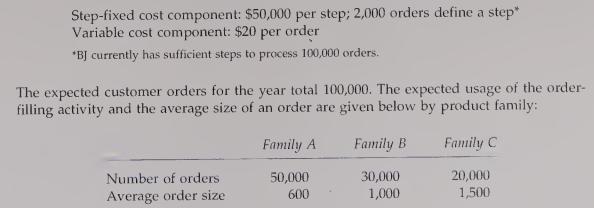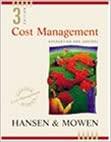BJ Manufacturing produces several types of potentiometers. The products are produced in batches according to customer order.
Question:
BJ Manufacturing produces several types of potentiometers. The products are produced in batches according to customer order. Although there are a variety of potentiometers, they can be grouped into three product families. The number of units sold is the same for each family. The selling prices for the three families range from $0.50 to $0.80 per unit. Because the product families are used in different kinds of products, customers also can be grouped into three categories, corresponding to the product family they purchase. Historically, the costs of order entry, processing, and handling were expensed and not traced to individual products. These costs are not trivial and totaled $4,500,000 for the most recent year. Fur¬
thermore, these costs had been increasing over time. Recently, the company had begun to emphasize a cost reduction strategy; however, any cost reduction decisions had to contribute to the creation of a competitive advantage.
Because of the magnitude and growth of order-filling costs, management decided to explore the causes of these costs. They discovered that order-filling costs were driven by the number of customer orders processed. Further investigation revealed the following cost behavior:

As a result of the cost behavior analysis, the marketing manager recommended the impo¬
sition of a charge per customer order. The president of the company concurred. The charge was implemented by adding the cost per order to the price of each order (computed using the projected ordering costs and expected orders). This ordering cost was then reduced as the size of the order increased and eliminated as the order size reached 2,000 units. (The marketing manager indicated that any penalties imposed for orders greater than this size would lose sales from some of the smaller customers.) Within a short period of communi¬
cating this new price information to customers, the average order size for all three product families increased to 2,000 units.
Required:
1. BJ traditionally has expensed order-filling costs (following GAAP guidelines). Under this approach, how much cost is assigned to customers? Do you agree with this prac¬
tice? Explain.
2. Consider the following claim: By expensing the order-filling costs, all products were undercosted; furthermore, products ordered in small batchesf are significantly under¬
costed. Explain, with supporting computations where possible. Explain how this analy¬
sis also reveals the costs of various customer categories.
3. Calculate the reduction in order-filling cost produced by the change in pricing strategy.
(Assume that resource spending is reduced as much as possible and that the total units sold remain imchanged.) Explain how exploiting customer linkages produced this cost reduction. BJ also noticed that other activity costs, such as those for setups, scheduling, and material handling costs, were reduced significantly as a result of this new policy.
Explain this outcome and discuss its implications.
4. Suppose that one of the customers complains about the new pricing policy. This buyer is a lean, JIT firm that relies on small frequent orders. In fact, this customer accounted for 30 percent of the Family A orders. How should BJ deal with this customer?
5. One of BJ's goals is to reduce costs so that a competitive advantage might be created.
Describe how the management of BJ might use this outcome to help create a competi¬
tive advantage.
Step by Step Answer:

Cost Management Accounting And Control
ISBN: 9780324002324
3rd Edition
Authors: Don R. Hansen, Maryanne M. Mowen





